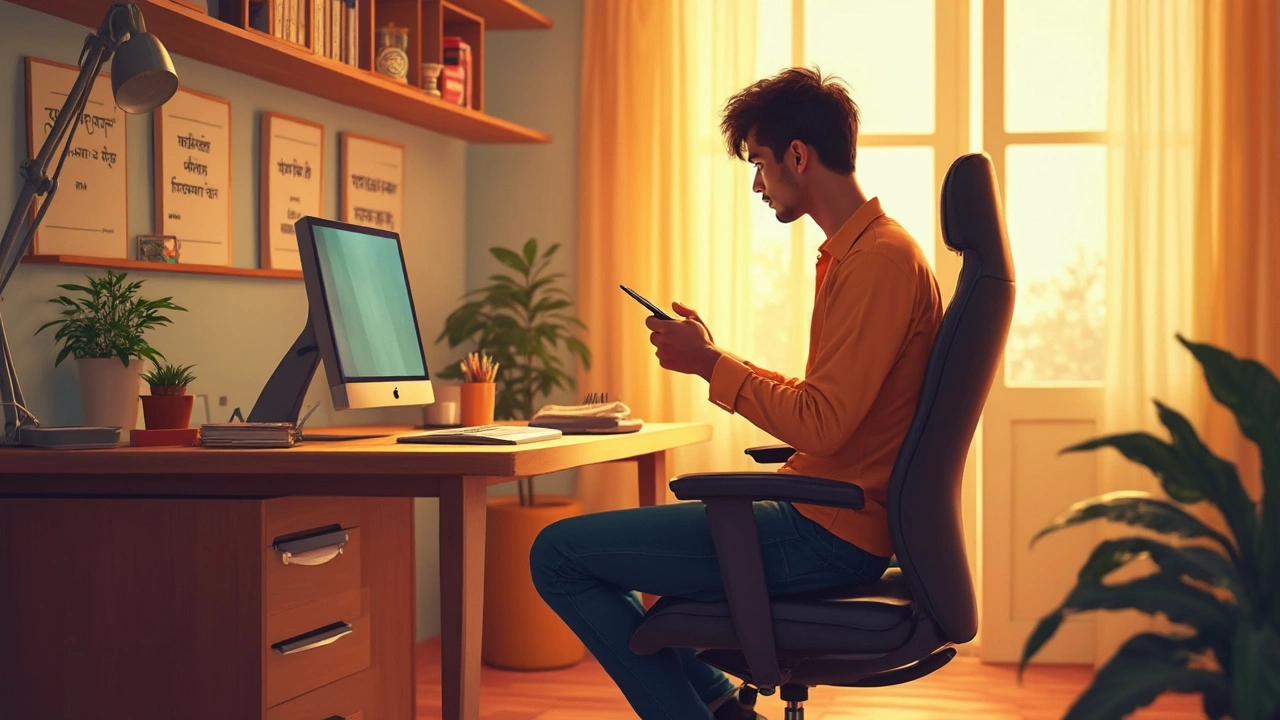If you’re sinking into a random chair every day and your back aches by lunchtime, you’re not alone. Most chairs—especially those cheap desk specials—just aren’t built for eight-hour marathons. Slouching, hunching, or perching on the edge is a one-way ticket to sore muscles and cranky moods.
The truth is, your chair sets the tone for your workday. The best chair for sitting long hours isn’t about racing stripes or fancy materials; it’s about support where your body needs it most. Think lumbar support, adjustable armrests, and a seat that doesn’t go numb after two Zoom calls.
I’ve road-tested more than a few setups while chasing my kid around and squeezing in deadlines. What shocked me? Tiny adjustments can be just as game-changing as a fancy new chair. If your body’s already yelling at you, don’t freak out—I’ll share tweaks you can make to your current seat that deliver instant relief.
- Why Regular Chairs Just Don’t Cut It
- Features That Actually Make a Difference
- Popular Chair Picks: Tried and Tested
- Quick Upgrades for Any Chair
Why Regular Chairs Just Don’t Cut It
If you grabbed an old dining chair for your home office, you’re not alone, but your back probably isn’t happy about it. Most ordinary chairs are built for short bursts of sitting, like grabbing dinner or a quick coffee chat. They just don’t offer the support or adjustability you need if you’re grinding out an eight-hour workday—which is why so many of us end up with aches and stiffness.
Here’s the deal: sitting for long hours in a regular seat sidelines your spine. A study from the University of Waterloo found that non-ergonomic chairs can lead to a slouched posture, making back pain up to 50% more likely if you’re parked there for hours. Regular chairs may have decent cushions or look good, but they usually lack three things your body actually needs:
- Lumbar support for your lower back
- Adjustable seat height and depth
- Armrests that move with you
According to Dr. Alan Hedge, an expert in ergonomics from Cornell University, "Most basic chairs ignore human anatomy. Without proper support, your muscles have to pick up the slack, and that causes pain by mid-afternoon."
“If your chair can’t be fine-tuned to your height and posture, it’s just not made for real work.” — Dr. Alan Hedge, Cornell University
Here’s a quick comparison table highlighting why a best office chair matters for sitting long hours compared to the average kitchen chair:
| Feature | Standard Chair | Best Office Chair |
|---|---|---|
| Lumbar Support | No | Yes |
| Seat Height Adjustment | No | Yes |
| Armrest Adjustment | No | Yes |
| Padded Seat | Sometimes | Always |
So if you’re serious about your health and productivity, regular chairs just won’t cut it. You need gear designed with your actual body in mind.
Features That Actually Make a Difference
If you’re picking the best office chair for long hours, features make or break your day. Here’s what to look for if you want comfort and less back pain, especially if you’re clocking in serious desk time.
- Lumbar support: Your lower back takes a beating when you sit still for hours. Chairs with built-in lumbar support—especially those you can adjust up and down—help keep your spine in a healthy shape. No more slumping like a question mark by 3 p.m.
- Seat depth and cushioning: If the seat’s too shallow, your thighs end up dangling, and that’s bad for circulation. Too deep, and you slouch. Good desk chairs let you adjust how far back the seat goes. Plus, quality foam that keeps its shape beats memory foam that turns into a pancake after a month.
- Adjustable armrests: Fixed arms force your shoulders up or leave them hanging. Look for armrests that raise, lower, and slide in or out. This keeps your wrists lined up and helps if you switch tasks a lot.
- Recline and tilt lock: Leaning back once in a while gives your spine and core a break. The most comfortable ergonomic chair lets you rock gently or lock the angle where you want it. No one sits bolt upright all day (and you shouldn’t).
- Breathable materials: Ever peel yourself off a fake leather chair in summer? Mesh backs let air flow and help you stay cooler when the office heats up. If mesh isn’t your thing, at least go for a fabric that doesn’t trap sweat.
- Sturdy wheels and base: Solid wheels on a five-point base keep you from tipping over when you’re reaching for something. If you have carpet, look for wheels made for it. If you’re on hard floors, soft wheels are the way to go.
Want numbers? According to a study from the ergonomics research group at Cornell, proper lumbar support can reduce lower back pressure by up to 30% compared to standard office chairs without it. That’s not just marketing hype—your back really can tell the difference.
| Feature | Why It Matters | Key Adjustment |
|---|---|---|
| Lumbar Support | Reduces lower back pain | Height/Depth adjustable |
| Seat Depth | Improves leg circulation | Seat slides in/out |
| Armrests | Prevents shoulder/wrist strain | Adjust up/down, in/out |
| Recline/Tilt | Relieves spinal pressure | Lock or free tilt |
| Material | Prevents overheating | Mesh or breathable fabric |
Focus on these basics before falling for extra gadgets or looks. The right mix keeps you comfy, keeps you working, and keeps you from turning into a grouch by dinner time.

Popular Chair Picks: Tried and Tested
If you google ‘best office chair,’ you’re drowning in options. I’ve narrowed down a handful that actually live up to the hype—and, yes, I’ve plopped down in each one long enough to know if my lower back would protest.
- Herman Miller Aeron: This one pops up in pretty much every roundup and for good reason. The mesh back keeps you cool, the lumbar support is dialed in, and you can tweak almost everything—seat height, tilt, arm position. Pricey? Oh yeah. Worth it if back pain is your daily nemesis.
- Steelcase Leap: This chair is a beast at support and adjustability. The flexible back moves with you, meaning no stiff, locked-in feeling. Plus, the seat edge flexes so no more pinched thighs after hours at your computer. People (myself included) swear by it for long stretches at a desk.
- Secretlab Titan Evo: If you want more than the typical ‘office’ look and love a gaming chair vibe, this is the sweet spot. The headrest and built-in lumbar support beat most of the big, blocky gaming chairs out there. It’s wider, the seat is firm, and it holds up after months of daily use—even Otis’s sticky hands couldn’t mess it up.
- HON Ignition 2.0: If you’re after decent ergonomics without smashing your wallet, this one’s got you. Adjustable arms, good lumbar, and a mesh back so you don’t overheat on long days. Not as plush as the Aeron, but half the price and plenty of support for the cost.
Here’s a quick rundown of features people usually care about—stacked side by side:
| Chair | Adjustable Lumbar | Mesh Back | Max Load (lbs) | Price (USD) |
|---|---|---|---|---|
| Herman Miller Aeron | Yes | Yes | 350 | ~$1500 |
| Steelcase Leap | Yes | No | 400 | ~$1100 |
| Secretlab Titan Evo | Yes | No | 285 | ~$550 |
| HON Ignition 2.0 | Yes | Yes | 300 | ~$400 |
If your budget is tight, check for used models or open-box deals. Many big companies refresh their office setups every few years, so you can score a premium desk chair for a fraction of the sticker price. No reason to pay top dollar if you don’t have to.
Quick Upgrades for Any Chair
Not everyone can buy an expensive best office chair right away, and honestly, even a regular desk chair can work if you tweak a few things. The good news is, you don’t need a PhD in ergonomics or a giant budget—just a few small changes can make a huge difference when you’re sitting long hours.
First, let’s talk back support. Most basic chairs don’t have enough lumbar help, so grab a pillow or a rolled-up towel and wedge it behind your lower back. You’d be surprised—the American Chiropractic Association backs this trick for easing strain during the day.
- Raise your monitor: Place books or a sturdy box under your screen so it sits right at eye level. If you’re craning your neck down, you’re going to pay for it with tension headaches and sore shoulders.
- Check your feet: You want them flat on the ground, not dangling. If you’re short, use a shoebox or a footrest. It helps put less stress on your lower back over time.
- Cushion the seat: Got a stiff or thin seat? A simple foam cushion or even a folded blanket works. Pressure relief means you’re not wiggling every five minutes.
- Adjust your arm position: Your arms should relax at your sides with elbows bent around 90 degrees. If your chair’s arms are too low or high, toss on a folded towel or find some stick-on pads.
- Take breaks: No chair can save you if you sit for hours straight. Set a timer to stand and stretch for a few minutes every half hour. Study out of Stanford in 2023 found standing up for just a couple minutes every 30 to 60 minutes drops that fatigue and muscle ache feeling—a win for anyone glued to their desk.
Want a snapshot of how small upgrades compare to the cost of a new ergonomic chair? Check out this quick breakdown:
| Upgrade | Average Cost |
|---|---|
| Lumbar pillow | $15–$30 |
| Seat cushion | $20–$50 |
| Monitor riser | $10–$40 |
| Footrest | $15–$40 |
| Best office chair | $300+ |
These upgrades might look like hacks, but tons of office workers swear by them because they just work. If you want to stretch your desk setup before dropping hundreds on a new desk chair, this is where to start. Your back—and your wallet—will thank you.

